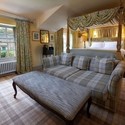Fire safety of furniture and furnishings
Photo by: The Devonshire Arms at Pilsley

Disclaimer
Disclaimer: While every effort has been made to ensure the accuracy of the information contained in the Pink Book, we regret that we cannot be responsible for any errors. The Pink Book contains general information about laws applicable to your business. The information is not advice and should not be treated as such. Read our full disclaimer.
Key facts
If you provide hotel or bed and breakfast accommodation, or operate a pub, restaurant or medium hazard attraction, which includes indoor premises where public entertainment is provided, you need to purchase furniture and furnishings that comply with commercial fire safety standards.
If you provide self-catering accommodation or have a low hazard attraction, such as a museum or exhibition that contains upholstered furniture, you need to comply with the Furniture and Furnishings (Fire) (Safety) Regulations 1988.
All furniture (new and second-hand) in self-catering accommodation or low hazard attractions that is covered by the regulations must comply with certain safety tests.
An agency’s liability for the fire safety of the furniture in the properties it handles depends on the terms of its arrangement with the accommodation owner.
Fire safety of furniture in all premises
The British Standards Institution (BSI) defines four categories of fire risk for all premises: low hazard, medium hazard, high hazard and very high hazard.
Residential properties and self-catering properties, along with attractions such as museums and exhibitions, are deemed to be low-hazard, while bed and breakfast accommodation, hotels, places of public entertainment, casinos, pubs and restaurants are deemed to be medium-hazard because they are generally larger and occupied by more than one party.
For low-hazard properties, you are able to use furniture and furnishings that meet fire safety standards for domestic properties. As such, you are able to use any new products from a reputable supplier because this is the minimum standard for all manufacturers and retailers. However, you are still required to comply with the Furniture and Furnishings (Fire) (Safety) Regulations 1988, which cover domestic furniture and furnishings.
For medium-hazard properties, the BSI states that furniture and furnishings should comply with standards BS 7176 (upholstered furniture), BS 7177 (bed bases and mattresses) and BS 5867 (curtains and drapes), which provide greater fire protection than domestic products. This commercial or contract furniture should meet CRIB 5/Ignition Source 5 standards, which means it has been tested for fire safety and is often sold by specialist companies. When ordering furniture for medium hazard premises, it is important to ensure that it complies with these standards. Your local fire safety officer will be able to advise.
The Furniture and Furnishings (Fire) (Safety) Regulations 1988
The Furniture and Furnishings (Fire) (Safety) Regulations 1988 (as amended) set fire resistance standards for upholstered furniture in domestic use (new and second-hand).
Do the Furniture and Furnishings (Fire) (Safety) Regulations apply to me?
Yes: if you are providing self-catering accommodation that contains upholstered furniture or have an attraction that is deemed to be low hazard.
What do the regulations cover?
The regulations apply only to upholstered furniture supplied for domestic use, a type of use that implies a low fire hazard. Most holiday lets are regarded as constituting domestic use and, therefore, are covered by the regulations.
Furniture designed to cope with a greater fire hazard (for example hotel beds and chairs) is available and may be offered to you by some retailers. When re-equipping your self-catering property, it will normally be for you to decide whether or not you require the new furniture to meet these higher fire resistance standards. If in any doubt, check with your local fire authority.
For simplicity’s sake in the information that follows, furniture and furnishings is referred to as ‘furniture’.
What furniture is affected?
To come within the scope of the regulations, furniture must be upholstered. Such furniture would include:
- Domestic furniture, including children’s furniture;
- Beds and divans (including their bases and headboards), mattresses of any size;
- Sofa beds, futons and other convertibles;
- Nursery furniture (for example highchairs, cots and playpens);
- Domestic garden furniture;
- Scatter cushions and seat pads;
- Pillows;
- Furniture in new caravans.
The regulations also apply to loose and stretch covers for furniture.
What furniture is not affected?
The regulations do not apply to:
- Bedclothes (including duvets);
- Loose covers for mattresses;
- Pillowcases;
- Curtains;
- Carpets;
- Sleeping bags;
- Goods made before 1 January 1950 and the materials used to reupholster them.
Main provisions of the regulations
All furniture (new and second-hand) in self-catering accommodation or low-hazard attractions that are covered by the regulations must comply with certain safety tests. These are very broadly as follows:
- Upholstered furniture must pass a prescribed cigarette resistance test;
- Cover fabric, whether for use in permanent or loose covers, will normally have to pass a match resistance test;
- Filling materials for all furniture must pass ignitability tests as specified in the regulations;
- All new upholstered furniture (except mattresses and bedding) and loose and stretch covers for furniture must carry a permanent label detailing compliance with fire safety requirements. Always look for these labels before buying any upholstered furniture for your property.
If you are having items reupholstered, make sure that the materials used comply with the regulations. However, remember that the regulations do not apply to materials used to re-upholster furniture made before 1950, unless that furniture is being significantly reworked and upholstered.
Can I use fire-inhibiting sprays to increase the life of my existing furniture?
These sprays are available from a number of companies who will treat the furniture for you. However, the Local Government Association and the Department for Business, Energy and Industrial Strategy (BEIS) advise operators to exercise extreme caution in using them because of issues relating to their durability. The treatment may, for example, be rendered ineffective by laundering.
Before deciding to have your furniture treated, you should:
- Remember that the regulations apply both to covers and to filling materials;
- Make absolutely sure that the spray on offer is appropriate for the covers and filling materials used in your furniture;
- Be sure that the spray will not be affected by previous treatments (for example waterproofing) carried out on the furniture;
- Bear in mind that some sprays are not water-resistant and will wash out, even when fluids, such as tea, are spilled on the treated fabric;
- Ask the company to provide strong evidence and guarantee that the spray does what it is supposed to do.
If the furniture which you have had treated is subsequently found not to meet the fire resistance standards specified in the regulations, it will be you (as the supplier of the furniture), and not the supplier or manufacturer of the spray, who is held responsible under this legislation.
Are letting agencies caught by the regulations?
Possibly. Whether or not an agency is liable for the fire safety of the furniture in the properties it handles will depend on the terms of its arrangement with you, the owner of the accommodation.
It seems that agencies that do no more than market your property and take bookings are unlikely to be liable. However, agencies that also manage and maintain properties on an owner’s behalf could possibly be liable.
As this is something of a grey area, some marketing/booking agencies cover themselves by including a clause in their contracts with owners which commits those owners to ensuring that their property complies at all times with these regulations (and others).
Expect any prospective agency to ask about the fire resistance standards of your furniture before it agrees to take your property on to its books.
Review of the Regulations
In 2023, the Office for Product Safety and Standards and the Department for Trade undertook a consultation on a new approach to the fire safety of domestic upholstered furniture, including the publication of a draft set of new regulations setting out essential safety requirements that all products in scope of the regulations must meet in order to be placed on the market, including the supply of furniture in holiday accommodation. However, following the 2024 election, the development of the new regulations has been delayed and it is uncertain as to when they will now be introduced. Operators are therefore advised to contact their local trading standards officer when undertaking refurbishments.
Further guidance
Your local authority
For further assistance, contact the Trading Standards department of your local authority.
Further guidance on the regulations
You can download A Guide to the Furniture and Furnishings (Fire) (Safety) Regulations from the Government archive.







